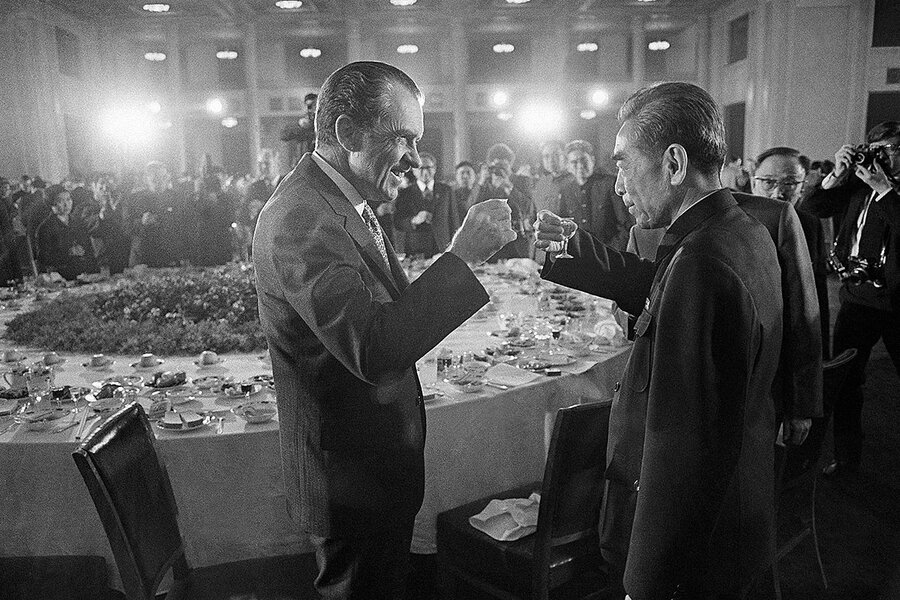For US-China relations, a day of reckoning
Loading...
| London
No international relationship matters more. And amid all the political tremors caused by the COVID-19 pandemic, ties between the United States and China are about to enter their most fraught period in decades.
It may not prove the end of an era – a definitive halt to the process of engagement begun with the Nixon administration’s dramatic opening to Beijing in 1972. A full break would mean major economic and financial costs for both sides. That’s an especially serious risk now, coming on top of the huge damage already done by shutdowns aimed at stemming COVID’s spread.
But at the very least, a fundamental reassessment seems inevitable. And a series of recent developments – such as the way President Donald Trump has made criticism of China a centerpiece of his reelection campaign and Beijing’s move to impose tough new security legislation on Hong Kong – suggest we’re at a critical pivot point.
Why We Wrote This
As the U.S. relationship with China worsens, some are predicting a new Cold War. Such decoupling seems unlikely, but a shifting mood in Washington suggests a pivot point may be close.
Tensions had been building long before COVID, mind you.
On the U.S. side, they were rooted in frustration over a growing imbalance in the relationship. Where China had once been largely a source for lower-cost consumer goods, it had grown into a modern and increasingly high-tech economy: the world’s second largest. Beijing was using state aid, exchange rate adjustments, strong-arm restraints on foreign companies, and industrial espionage to steal a march on competitors, U.S. officials charged.
There were other tensions, too, rooted in political changes. In the U.S., these were embodied by the election of President Trump on his “America First” platform; in China, by the shift from a collective, more rules-based and open system in the early 2000s to the rule of President Xi Jinping. Since coming to power in 2012, he has consolidated his authority, done away with presidential term limits and instituted the most pervasive regimen of Communist party control since the rule of Mao Zedong. He has also moved to expand China’s influence and power abroad.
But sometimes in international relations, a single event or crisis does more than aggravate existing tensions. Like a freeze-frame, it dramatically highlights the core issues behind them, and leads to a shift in direction. One example: In 2014, the toppling of the pro-Moscow government in Ukraine was followed by Russia’s military intervention, its annexation of Crimea, and a systematic tightening of Western sanctions.
For the U.S.-China relationship, COVID-19 has played a similar role. In one sense, that may have been inevitable: The virus got its start in the Chinese city of Wuhan, where the authorities initially tried to hide it.
But the political and economic shockwaves that the pandemic spread in Europe and the U.S. also painfully underscored mounting concerns about the West’s relationship with China.
On the political front, once President Xi’s government got COVID-19 under control he resisted calls for an independent inquiry into its origins, while also reframing the public narrative to contrast China’s “success” with the failure of Western democracies to stem the pandemic effectively.
Economically, the initial Chinese shutdown underlined the dependence of many U.S. and other Western businesses on supply chains starting in China. That dependence became even more starkly evident when countries and companies had to scramble for ventilators and personal protective equipment to deal with COVID-19. By far the majority of these items were now made in China.
There are already signs of reassessment. A bipartisan coalition in the U.S. Congress is looking for ways to loosen these dependencies – and also now for ways to react if President Xi follows through on his move to end Hong Kong’s autonomy in matters like free speech, an independent judiciary, and the rule of law. Europe, too, is looking at ways of strengthening its own capacity to produce strategically important goods, as well as to forestall possible efforts by Chinese firms to buy Western businesses weakened during the pandemic.
The longer-term question is whether we’re headed for something like the Cold War with the old Soviet Union.
In one sense, the parallel is illusory. China is much more advanced economically, and more intricately connected with the international economy, than Soviet Russia ever was.
There are still the makings of a Cold War-style rivalry, however. China has staked out a military presence in the South China Sea and, through its Belt and Road infrastructure-building initiative, has made itself felt economically and diplomatically across central and south Asia and in Africa and Europe. President Xi’s consolidation of power has also drawn a Cold War-style ideological dividing line between his increasingly totalitarian regime and democratic governments in the West.
Yet the world has changed since the Cold War in ways that could determine how any new China relationship evolves. Back then, besides arms control, there were no major international issues requiring U.S.-Soviet partnership. Now, in order to deal effectively with tomorrow’s top challenge – climate change – the U.S. and China will need to work together. And the world economy as a whole would suffer heavily from a purely adversarial relationship between its two major powers.
There’s also been another change. During the Cold War, the U.S. relied not just on its own strength. It could count on strong military, political, and economic bonds with other democracies, and the international weight of its democratic example.
For now, at least, Washington seems much less interested in this “soft power,” and ties with its allies have been fraying badly. China, on the other hand, shows every sign of a continued determination to widen its global influence.






